Every year, the PEN Prison Writing Program recognizes the work of writers imprisoned throughout the country. Exiled from our schools and society, inmates submit manuscripts in every form to one of the only forums of public expression for incarcerated writers. The uncensored writings from this year’s Prison Writing Contest winners can be read in full on the PEN Prison Writing Awards website.
Pamphlet Press Wins Publisher Award
Experimental UK publisher Oystercatcher Press won the £5,000 UK poetry pamphlet publisher award. “They’re very new – they started in 2008 – and they’re quite open about what they want to do: experimental, avant garde work. All the judges liked that sense of direction,” said Judge Richard Price. “They also have innovative ways of making the most of a shoestring operation – a scheme to subscribe to pamphlets rather than buy them one by one, for example – and they publish poets from the 70s as well as contemporary work.” Read more on Guardian UK.
Eva Brann on BookTV
 Catch Eva Brann on BookTV on C-SPAN2 Saturday, August 1 @ 10:30 A.M. EDT (Repeated @ 5:00 P.M. EDT). Eva Brann is a senior lecturer at St. John’s College in Annapolis Maryland. Her books include Homeric Moments, The Music of the Republic, and Feel Our Feelings.
Catch Eva Brann on BookTV on C-SPAN2 Saturday, August 1 @ 10:30 A.M. EDT (Repeated @ 5:00 P.M. EDT). Eva Brann is a senior lecturer at St. John’s College in Annapolis Maryland. Her books include Homeric Moments, The Music of the Republic, and Feel Our Feelings.
Neustadt International Prize for Literature
The Neustadt International Prize for Literature is a biennial award sponsored by the University of Oklahoma and World Literature Today. The Prize consists of $50,000, a replica of an eagle feather cast in silver, and a certificate. A generous endowment from the Neustadt family of Ardmore, Oklahoma, and Dallas, Texas, ensures the award in perpetuity.
This year’s winner will be selected in October from the following candidates and their representative texts:
Ha Jin, War Trash
Ricardo Piglia, Artificial Respiration
Michael Ondaatje, Running in the Family / Divisadero
Haruki Murakami, The Elephant Vanishes
Margaret Atwood, The Blind Assassin
Duo Duo { poetry selections }
A. B. Yehoshua, A Woman in Jerusalem
Athol Fugard, My Children! My Africa! / The Island
Shahriar Mandanipour, Censoring an Iranian Love Story
For more information about the prize, visit World Literature Today.
Chronicle Books Summer Sale
Chronicle Books is offering 35% off with the coupon code FRIENDS at checkout through Aug 5 – along with free shipping with minimum purchase.
Summer Deals on Absinthe & Bloggers Wanted
Absinthe: New European Writing is offering a summer sale now through August 31st. Purchase any back issue (except sold out issue #3) for only $5 (postage included; $10 outside the United States). This is a great opportunity to complete your Absinthe set. Additionally, until August 31st you can order a lifetime subscription to Absinthe for only $100(for international subscribers the lifetime rate is $200).
Absinthe is also looking for writers interested in contributing to their blog. If you’re interested, email the editor: dhayes_at_absinthenew.com
Residency: Soapstone
Soapstone is accepting applications until August 1, 2009 for residencies starting November 2009 to November 2010.
From the Soapstone website:
Soapstone provides women writers with a stretch of uninterrupted time for their work and the opportunity to live in semi-solitude close to the natural world.
In addition to that rare but essential commodity for a writer—a quiet space away from jobs, children, and other responsibilities—Soapstone provides something less tangible but also invaluable: the validation and encouragement necessary to embark upon or sustain a long or difficult writing project.
Located in Oregon’s Coast Range, nine miles from the ocean, the retreat stands on twenty-two acres of densely forested land along the banks of Soapstone Creek and is home to much wildlife. The writers in residence enjoy a unique opportunity to learn about the natural world and join us in conscious stewardship of the land.
Soapstone is set up for two writers at a time, each with her own writing studio. From an applicant pool of 400 to 500, approximately thirty-five writers each year are awarded residencies of one to four weeks.
Sweet Summer Sale: Dalkey Archive Paperbacks
Through Wednesday, July 29 every Dalkey Archive paperback edition is on sale, with free shipping within the United States (outside the U.S. email Melissa Kennedy directly at kennedy_at_dalkeyarchive.com for shipping costs). When you click on one of the offers, it will take you to a shopping cart page, then just list the titles you would like in the “comments” box that will appear prior to checkout. Shop before you drop!
And remember, if not for you – consider supporting your local public and school libraries by adding some great titles to their collections!
5 books for $35 w/free shipping
10 books for $65 w/free shipping
20 books $120 w/free shipping
PEN America Takes on the Surveillance Progam
This past week, PEN American Center has been in court challenging the U.S. government’s massive warrantless surveillance program. The hearing took place at 10:00 a.m.. in U.S. District Court in New York. It came amid new revelations that National Security Agency’s telephone and Internet surveillance program has been collecting the private communications of Americans in clear violation of longstanding legal limits on such domestic surveillance activity.
More information about their actions can be found on the PEN website, along with a sample letter interested readers/activists can send to their members of congress on the issue of warrantless surveillance.
Michigan Park & Read
 Park & Read Program Offers Free Park Passes for Michigan Readers
Park & Read Program Offers Free Park Passes for Michigan Readers
Looking for ways to save some “green” while being “green”? Then visit your local library this summer! Michigan’s Department of Natural Resources has partnered with the Library of Michigan, Macy’s, and the Hammock Company to announce the “Park & Read” program.
Park & Read allows library-card holders the ability to “check-out” a one-day pass into any Michigan state park or recreation area in lieu of the resident daily motor vehicle permit. This is a $6 savings and free access to the more than 500 events taking place in local parks this summer.
Plus, many parks will have a hammock available for Park & Read participants to borrow while on-site for the day so they can fully enjoy a great book in Michigan’s great outdoors.
“We want everyone in Michigan to know what a fantastic resource their local park can be,” says Maia Stephens, Recreation Programmer for the DNR. “Because the program is free, everyone can now enjoy all the free activities available in Michigan State Parks and Recreation Areas. Besides, what’s more relaxing than a day at the beach with a good book?”
Passes are valid for seven days from check-out and can be used for one day at any one of Michigan’s state parks. Hammocks are subject to availability. This program runs through September 25.
July Lit Mag Reviews Online
Click on over to read the July lit mag reviews – a great selection of new, established, print, and online journals – NewPages Literary Magazine Reviews: A Cappella Zoo, Agriculture Reader, Bellingham Review, Beloit Poetry Journal, Chtenia, Exquisite Corpse, Field, Glimmer Train, Greensboro Review, Gulf Coast, Hayden’s Ferry Review, H.O.W. Journal, The Literary Review, LITnIMAGE, Meridian, Mizna, Monkeybicycle, New Ohio Review, the new renaissance, New York Quarterly, Potomac Review, Rattle, Red Rock Review.
Colorado Higher Ed in Trouble Too
Pikes Peak Community College President Tony Kinkel comments on the prospect of losing state funding entirely: “I don’t know that we could keep the doors open,” he says. At a minimum, he adds, the college would have to increase tuition by 50 percent, close its Falcon campus and use only adjunct faculty. (Colorado Springs Independent, “Death to Higher Ed“)
Ouch.
UC Berkley – oh no…
Things are not looking good for UC Berkley in this time of economic crisis. If there was ever a canary in a coal mine, this is one that – as an educator – makes my stomach turn.
Some Notes on Character
*NOTE: Reposting with links to Conclave full-text. Thanks Valya.*
I ran across a couple of great editorials in the most recent issues of American Short Fiction and Conclave. Both speak the the nature of character in writing as well as, for Conclave, in photography. Below are some excerpted portions which create a kind of conversation between them.
From Editor Stacey Swann of American Short Fiction (44, Summer 2009):
Like most writers, I grew up reading books—loving the characters and their stories. But I also loved learning about the world. While I understood that Narnia was not a real place or Tom Sawyer a real person, I still invested a great deal of authority in authors: the way they viewed the world was correct on a fundamental level. This explains why studying John Keats’s “Ode on a Grecian Urn” in high school remains a vivid memory for me. It was the first time I strongly disagreed with what an author was espousing. No matter what Keats thought, no matter what my English teacher echoed, I was certain that beauty was not truth and truth was not beauty. It wasn’t just that many fundamental truths about the world were ugly; beauty wasn’t important enough to equate with truth.
It turns out that I was not alone in my distrust of this ode. In one of his critical essays, T. S. Eliot wrote that those last two lines were “a serious blemish on a beautiful poem, and the reason must be either that I fail to understand it, or that it is a statement which is untrue.” Eliot continued: “And I suppose that Keats meant something by it, however remote his truth and his beauty may have been from these words in ordinary use.”
In high school, I equated beauty with nothing more than an excessive prettiness. Beauty was something to be applied to objects, not actions. I recently realized that I had readjusted my definition of beauty, and I might now understand Keats’s meaning a little better. As I get older I see beauty in so many unexpected things. And when I think about short stories, it seems to me that most depict moments of beauty. While novels generally are about characters and large portions of their lives, short stories must value something else due to their compactness. So often, they are illuminations of an action with inherent beauty. The beauty may be sad or painful or wasted, but it is nonetheless beautiful.
Conclave, a new lit on the block, focuses on “character-driven writing and photography.” Founding Editor Valya Dudycz Lupescu discusses the selection process for their inaugural issue:
As we reviewed and narrowed the pool, the editors discussed what made the pieces character-focused. There was no rubric or list of points. Beyond obvious assessment of craftsmanship, so much of this process is subjective. How can one quantify the literature that compels us to read it?
William Faulkner once said, “It begins with a character, usually, and once he stands up on his feet and begins to move, all I can do is trot along behind him with a paper and pencil trying to keep up Tong enough to put down what he says and does.”
In a good character-driven story, the reader should be swept up into the lives of the characters, willing to trot alongside them as they tell their stories. In an excellent character-driven story, the reader is compelled to follow the characters anywhere, outside his or her comfort zone, into alien territory, or into new emotional depths. We willingly suspend all disbelief to immerse ourselves in their reality. These unforgettable characters are timeless. They reveal something about human nature that is archetypical and personal at the same time. [Full text here.]
Conclave Managing Editor Scott Markwell adds these comments to the consideration of character:
As we observe character, we also see how it changes, how people grow, stay static, or regress. . . . Character reveals the brightest and darkest places of who we are. Characters come alive when they reveal a truth, when they hold a mirror up to each of us. . . . Character comes in other interesting forms. We personify. The inanimate become real, become human, express features we see in others. We find character in metaphor and in the literalness of life’s events. We see the wisdom and ravages of age. . . . Character will change, but we hope the truth of the human experience will not. [Full text here.]
Which echoes Swann’s closing line:
Finally, returning to Keats, if these stories are about moments of beauty, there is something inextricably true about them as well. It is their truth that makes them beautiful.
[Swann’s full editorial available here.]
Jobs :: Various
Shippensburg University of Pennsylvania tenure-track assistant professor in Creative Writing, Fiction, full-time appointment beginning August 2010. Nov 2
The Department of English at Wheaton College invites applications for a tenure-track position in creative writing. Dr. Sharon Coolidge. Nov 13
Poet-in-Residence Olivet College (Michigan)
Olivet College (MI) Humanities Department 2011 Sandburg-Auden-Stein Residency. Intensive Learning Term poet-in-residence program, late April to mid May 15, 2011. Submissions are due on September 10, 2009.
Polaroid Farewell Exhibit
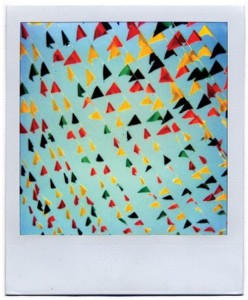 ISM: a community project and Hibbleton Gallery pay tribute to instant film and the discontinued Polaroid 600 Series with a gallery exhibition + limited edition book.
ISM: a community project and Hibbleton Gallery pay tribute to instant film and the discontinued Polaroid 600 Series with a gallery exhibition + limited edition book.
The opening reception of INSTANT GRATIFICATION: a polaroid party is scheduled for 7:00 PM on Friday August 7th, 2009 at the Hibbleton Gallery in Fullerton, California. This event is scheduled to coincide with the projected date of expiration for the Polaroid 600 Series.
Polaroid submissions for the Gallery Exhibition + Limited Edition Book are open to the public. Please send polaroid submissions to kevin<-at->ismcommunity.org.
WE NEED TO RECEIVE ALL ORIGINAL POLAROIDS BEFORE FRIDAY, JULY 24.
Calling All Hemingway Look-Alikes
Sloppy Joe’s 29th Annual Papa Look-Alike Contest
Key West, FL
July 23-26, 2009
Sloppy Joe’s Bar in Key West will host its 29th Annual Hemingway Look-Alike contest July 23-26, 2009. The contest is one of many events in Key West to celebrate the birthday of Ernest Hemingway and honor his work as author and sportsman.
AsoloArtFilmFest Seeks Student Participants
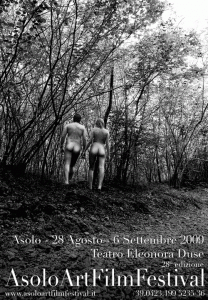 The AsoloArtFilmFestival (Italy) is inviting students between 18 and 26 year old to share their passion for cinema and art with other students from around the world. With it’s new “Student Hub,” AAFF wants to create an intercultural platform to exchange ideas, projects in a totally new creative setting inspired from the local tradition.
The AsoloArtFilmFestival (Italy) is inviting students between 18 and 26 year old to share their passion for cinema and art with other students from around the world. With it’s new “Student Hub,” AAFF wants to create an intercultural platform to exchange ideas, projects in a totally new creative setting inspired from the local tradition.
AsoloArtFilmFestival is offering free accomodations to a limited number of interested students. Visit the AsoloArtFilmFestival Student Hub for more information and an application. Deadline Aug 10
New MFA at CSUSB
Charmaine Boucher, Graduate Programs Administrator, English Department of California State University, San Bernardino wrote to introduce the new M.F.A. in Creative Writing program, in addition to their M.A.in English Composition:
M.F.A.
The M.F.A. program welcomes writers with fresh voices, expansive visions, and evident commitment into a diverse but tightly knit community. Based on the belief that the best education for the artist includes training in literature as well as the honing of craft, this two-year, terminal studio arts degree is designed to nurture talent while simultaneously preparing students for the challenges and joys that mark the writer’s life. Through workshops, seminars, and hands-on experience in the community at large, the program also prepares students for career opportunities in editing at publishing firms, newspapers and magazines, professional writing, work at foundation and arts organizations, and teaching at the community college and university level for tenure-track positions.
M.A. English Composition
The Masters of Art in English Composition is designed for students interested in pursuing studies in the fields of composition, literature and linguistics. The concentration in English Composition focuses on writing–how written texts work rhetorically and stylistically; how historical and social conditions affect what we write and how we construct meaning as we read; and how to teach people to write effectively. The literature concentration allows students an option to focus on advanced studies in literature as well as composition. The concentration in TESL emphasizes students with a wide range of teaching approaches and methods.
The Bauhaus: 90 Years / 90 Days
The Bauhaus celebrates its 90th anniversary this year, and “The Bauhaus: 90 Years / 90 Days” is a new project which commemorates the Bauhaus. Every day during this 90-day project (from July 6 till October 3), a project happens which creatively plays around with and pays homage to an aspect of the Bauhaus. Examples of those projects might include a dance performance inspired by Oskar Schlemmer’s ballet, a musical performance that uses a Kandinsky painting as a graphic score, a fiber art project inspired by Anni Albers’ work, a poem inspired by Walter Gropius’ architecture, a short story inspired by Marianne Brandt’s work, an essay reflecting on an aspect of the Bauhaus movement, and so on.
These events will be presented at different locations around the world. This website is being used to track and document day-by-day records of this project’s happenings. Part of “The Bauhaus: 90 Years / 90 Days” will be part of The Fourth Annual Chicago Calling Arts Festival (Oct. 1-11, 2009). “The Bauhaus: 90 Years / 90 Days” is being organized by the Borderbend Arts Collective and the Gropius in Chicago Coalition.
Music Meets Literature
Christian Goering, an assistant professor at the University of Arkansas and former high school English teacher, explains how he has students make connections with what they are reading in class to the music they listen to outside of class: musical intertextuality.
His site, Lit Tunes goes into much more detail and provides a number of classroom assignment examples.
Hard to be an International Festival When…
Top poets denied entry to UK for festival: “I feel ashamed that the UK is effectively becoming a fortress.” -Ledbury Poetry Festival director Chloe Garner
[Link fixed. DH]
Poetry Postcard Fest :: Sign Up Now!
I can’t recommend this activity highly enough! I did it last year, and was amazed at being able to write 31 poems (maybe not all sent on time, but that was fine – I was getting postcards well into September and October!), as well as receive many, many wonderful poems. The Perennial Project will also keep you writing year-round and becoming the biggest postcard junkie!
Call For 2009 August Poetry Postcard Fest Participants
Get yourself at least 31 postcards. These can be found at book stores, thrift shops, online, drug stores, antique shops, museums, gift shops. (You’ll be amazed at how quickly you become a postcard addict.)
On or about July 27th, write an original poem right on a postcard and mail it to the person on the list below your name. (If you are at the very bottom, send a card to the name at the top.) And please WRITE LEGIBLY!
Starting on August 1st, ideally in response to a card YOU receive, keep writing a poem a day on a postcard and mailing it to successive folks on the list until you’ve sent out 31 postcards. Of course you can keep going and send as many as you like but we ask you to commit to at least 31 (a month’s worth).
What to write? Something that relates to your sense of “place” however you interpret that, something about how you relate to the postcard image, what you see out the window, what you’re reading, using a phrase/topic/or image from a card that you got, a dream you had that morning, or an image from it, etc. Like “real” postcards, get to something of the “here and now” when you write.
Do write original poems for the project. Taking old poems and using them is not what we have in mind. These cards are going to an eager audience of one, so there’s no need to agonize. That’s what’s unique about this experience. Rather than submitting poems for possible rejection, you are sending your words to a ready-made and excited audience awaiting your poems in their mailboxes. Everyone loves getting postcards. And postcards with poems, all the better.
Once you start receiving postcard poems in the mail, you’ll be able to respond to the poems and imagery with postcard poems or your own. That will keep your poems fresh and flowing. Be sure to check postage for cards going abroad. The Postcard Graveyard is a very sad place.
That’s all there it to it. It’s that fun and that easy.
To check out what’s been done before, visit the blog [where you’ll also see the Perennial Poetry Postcard List of folks who try to write a postcard poem at least once a week regardless of receiving in order to keep connections flowing], Paul Nelson’s website or their Facebook group.
To get started, click here.
Joy Harjo the New Jared?
Well, not exactly, but she did make the Subway “Fit to Boom” feature.
Buy a Book, Save a Bookstore
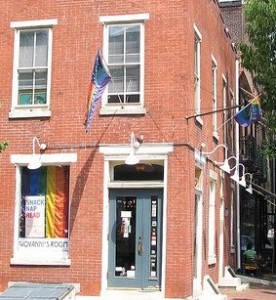 Reposted from CA Conrad at PhillySound:
Reposted from CA Conrad at PhillySound:
GIOVANNI’S ROOM BOOKSTORE in Philadelphia is the world’s largest Lesbian, Gay, Bisexual, Transgendered, Feminist bookstore. The catalog of titles it holds for us is staggering, and no where in any brick and mortar store, independent or corporate, can we find all these titles together to browse whenever we want, to purchase whenever we want. I worked at the store for nearly 7 years, and its importance for LGBT and feminist readers around the world was something I felt, and took seriously when it was felt.
While independent bookstores have been disappearing, none have been disappearing as quickly as queer/feminist bookstores. Corporate bookstores WILL NOT carry ALL these titles for you to discover. I remember a woman coming into the store who was 78 years old, and had been married, had children, and was now wanting to come out of the closet. The Coming Out section of books is unlike any other in the world, and I also showed her the video NITRATE KISSES. I forget what she purchased, but I remember feeling, truly feeling the importance of Giovanni’s Room Bookstore at helping create a place for this woman who was older than my grandmothers.
The store has survived MANY tough times, including bricks being thrown through the windows. The bricks from these hate crimes now line the owner’s garden. Edwin Hermance, Skip, and all their amazing staff and volunteers are facing an enormous crisis. Major reconstruction is about to take place on the store’s one wall, and it will cost A LOT of money. Edwin and Skip and all the staff want you to PLEASE shop at the store to help them in this time of need. IF THERE ARE BOOKS YOU WANT but cannot find, they WILL order them for you. Below is a note from Edwin Hermance with many more details. Please shop at Giovanni’s Room, for all our sake! CAConrad
————-
from Edwin Hermance, owner of Giovanni’s Room Bookstore
Giovanni’s Room, the oldest independent LGBT bookstore in the United States today, needs your help and support to survive. Our 12th St. wall, which is structurally unsound, must be taken down and rebuilt from the ground up; construction will begin by sometime in August. The cost of this renovation, roughly $50,000, will not be easily paid; independent bookstores, lgbt bookstores included, have never been that profitable. Our store’s success is measured by the people Giovanni’s Room has helped in an almost limitless number of ways and by the exposure we have given to authors and publishers, filmmakers and musicians.
This will be a delicate time in the store’s history. We need your support more than ever, and the store will remain open during the construction. Here is what we are asking you to do:
*Continue to shop at Giovanni’s Room despite the challenges.
*Order in person, online, by email, and by phone.
*Show your support!
We have often faced adversity. In the beginning, in 1973, we had hardly any books to sell and the store was staffed 100% by volunteers. When homophobic landlords evicted us from the Spruce Street location and no one, on a major street, would rent to Giovanni’s Room, we were able to raise the down payment for the current location by borrowing from you, our customers. Over 100 volunteers helped renovate the building to make the beautiful space we have occupied since 1979.
Now, at this defining juncture, we have formed a Committee that will be addressing fundraising, volunteers, special community and author events, and other activities to help meet the cost of this repair.
Keep gay heritage alive. Volunteer your time – make a financial pledge! Your support to Giovanni’s Room will help us survive our 36th year.
Edwin Hermance
***
Giovanni’s Room
345 South 12th St. (corner of 12th & Pine Sts.)
Philadelphia, PA 19107
215/923-2960
[email protected]
http://www.queerbooks.com/
New Lit on the Block :: Paul Revere’s Horse
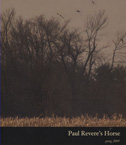 Paul Revere’s Horse has made a rather quiet entrance into the literary scene – with no great promotional fanfare or even editorial introduction to the premier issue. Edited by Bard College graduate Christopher Lura, the inaugural issues, Spring 2009, includes the works of Minnie Singh, Micaela Morrissette, Russell J. Duvernoy, John Murray, Christine Choi, Sam Truitt, Miranda Mellis, Graham Emory Guest, John K. Duvernoy.
Paul Revere’s Horse has made a rather quiet entrance into the literary scene – with no great promotional fanfare or even editorial introduction to the premier issue. Edited by Bard College graduate Christopher Lura, the inaugural issues, Spring 2009, includes the works of Minnie Singh, Micaela Morrissette, Russell J. Duvernoy, John Murray, Christine Choi, Sam Truitt, Miranda Mellis, Graham Emory Guest, John K. Duvernoy.
Paul Revere’s Horse is published biannually by Sawkill Press in San Francisco and accepts submissions of all types of literature and related texts.
[Reposted with correction. DH]
Creative Nonfiction Virtual Yard Sale
CNF is cleaning house and offering up to 80% discounts on their stuff. The sale runs until midnight EST July 31 with limited stock on some items.
Sale includes:
Subscriptions
* 8-issue U.S. Subscription
* 4-issue U.S. Subscription
* 4-issue U.S. Subscription plus Best CNF Volumes 1 & 2
Books
* Almost Human: Making Robots Think
* Connecting: 20 Prominent Authors Write About The Relationships That Shape Our Lives
* Forever Fat: Essays By The Godfather
* Healing
* In Fact: The Best Of Creative Nonfiction
* On Nature: Great Writers on the Great Outdoors
* Our Roots Are Deep With Passion
* Pittsburgh In Words
Back Issues
* Issue 10: Style and Substance
* Issue 19: Diversity Dialogues
* Issue 22: Creative Nonfiction in the Crosshairs
* Issue 23: Mexican Voices: Cronica de Cronicas
* Issue 26: The Poets & Writers Issue
* Issue 30: Our Roots are Deep with Passion
* Issue 31: Imagining the Future
* Issue 33: Silence Kills
* Issue 34: Anatomy of Baseball
CNF Merch
* CNF Mug
* CNF Shirt
* Silence Kills Audiobook
77 Books to Celebrate 60 Years
To celebrate the 60th year of the National Book Awards, the National Book Foundation will present a book-a-day blog on the Fiction winners from 1950 to 2008.
The blog will run from July 7th to September 21st, starting with Nelson Algren’s The Man With the Golden Arm, ending with Peter Matthiessen’s Shadow Country, and including works by Ralph Ellison, Saul Bellow, Philip Roth, Flannery O’Connor, Eudora Welty, and Alice McDermott. Discover lesser known but equally talented National Book Award Fiction Winners such as Conrad Richter, Wright Morris, and Robb Forman Dew.
On September 21st, readers will have a chance to select The Best of the National Book Awards Fiction and win two tickets to the 2009 National Book Awards, the first time in its history the Awards will open to a public vote.
New Lit on the Block :: Slush Pile
Who knew the Slush Pile is somewhere you would actually want to end up?
Editor M.R. Branwen knew it, and gathered up a team to beat all slush piles: Matthew Hotham, Poetry Editor; Sara Petras, Art Editor; Caroline Tanski, Copy Editor; David Thorpe, Music Reviewer – with room for what appears to be a couple more to join in the area of Movie Reviews and Advice.
This first “installment” into the pile, which follows a publication format similar to Anderbo, includes that journal’s number one, Rick Rofihe, as well as the following fiction contributors: Casey Lefante, Roland Goity, and Ben Miller.
Poetry kicks in with works by Cynthia Chin, Peter Conners, Mary Fuchs, Kythe Heller Hilary White, Emily Vogel, and Billy Collins – who, Mister Brawnen explains as “true story,” “contributed a poem to this issue in exchange for information about my tattoos.” – read the rest on the editorial.
David Thorpe reviews The Needy Visions, Laura Bradford, Craig MacNeil, The Last Front, and Thick Shakes.
Sara Petras Curates introduces a selection of paintings by Marian Brunn Smith.
Egan Budd contributes an essay to the “Slush” section: “Noise! Understanding the Mysterious Cacophony.” This section also already houses two archived works: “Vegetarian Touring Exploits: Japan” by Russell Lissack and “How to Write a Book in Ten Easy…Years” by Christina Thompson.
Slush Pile is currently accepting submissions in all areas.
Passings :: Frank McCourt
Frank McCourt has died today after a long bout with cancer.
Kevin Cullen of the Boston.com has a wonderful, comprehensive look at McCourt’s life and work from his long-standing professional relationship with the teacher/writer: Frank McCourt, the teacher. (via Ross Dallas)
New Lit on the Block :: Line4
Don’t let the location fool you: “founded in a condo in Austin, Texas” – not all great literary ventures are begun in bars. The powerhouse editorial/web design team behind Line4, Karyna McGlynn and Adam Theriault, have created a four-line approach to the epigram – accepting submissions of 3-15 4-line poems on a theme, preferably non-rhyming poems and with no individual titles.
The first issue of Line4 includes contributions from Emily Kendal Frey, Emily Mahan, Amanda Chiado, Nate Slawson, Andrew Lundwall, Josh Burge, Dan Nowak, and Jeffery Evans.
With submission criteria that includes a penchant for “funny, the juvenile, and the exclamatory! New Sincerity = A+. Also anything where high-brow and low-brow make sweet, sweet nudity. Political, pop-cultural & poetic commentary appreciated. Landscape page orientation is pretty nifty too.” – I don’t know how Line4 won’t soon be overrun with submissions – and appreciative readers!
The Boycott is On
Against a new policy in Britain that requires children’s book authors to register with a national database and undergo a criminal background check to prove they’re not sex offenders before they will be allowed to do readings in the schools.
61 Essential Postmodern Reads
61 essential postmodern reads: an annotated list by Carolyn Kellogg, NYT – with nifty graphic annotations that highlight “the author is a character, fiction and reality are blurred, the text includes fictional artifacts, such as letters, lyrics, even whole other books, and so on.”
Educational Resource :: World Literature Today
World Literature Today offers a selection of essays from their publication on this page. The essays are available full-text online, or as PDF downloads and may be copied and distributed for educational use. Here’s just a sample of some of the essays from this ten-year archive:
The Writer as Inocente
Rudolfo Anaya
Comix Poetics
Andrew D. Arnold
Among the Gypsies
Garth Cartwright
Beyond The Hobbit
J.R.R. Tolkien’s Other Works for Children
Janet Brennan Croft
Tough Guys with Long Legs: The Global Popularity of the Hard-Boiled Style
J. Madison Davis
On Translation and Being Translated
Kerstin Ekman
Fifteen High Points of Twentieth-Century Peruvian Poetry
Ricardo Gonzalez Vigil
On Writing Short Books
Kristjana Gunnars
Writing and Place
Abdulrazak Gurnah
Spotlight: Dylan and Guthrie
Another Side of Bob Dylan
Tim Riley
The International Children’s Literature Movement
Carl M. Tomlinson
Sweet 102 for Eleanor
 Thanks to any of you NewPages readers who sent a birthday card to 102-year-old Eleanor Wenner, whose story I posted earlier this month.
Thanks to any of you NewPages readers who sent a birthday card to 102-year-old Eleanor Wenner, whose story I posted earlier this month.
The nursing facility where she and her husband reside was hoping to receive 102 birthday cards to help Eleanor celebrate. To date, Eleanor has received 1109 birthday cards, with some coming from the Netherlands, Scotland, England, Ireland, Finland and almost every state in the USA.
Editorial Board Members Sought
Red Feather Journal is a new online, international, interdisciplinary, peer-reviewed, English-language journal that provides a forum for scholars and professionals to interrogate representations of children in all aspects of visual media: film, television, the Internet, video gaming, advertisements, etc.
Red Feather Journal’s premier issue is scheduled for release February, 2010.
RFJ is currently seeking editorial board members who are interested in the ongoing discourse about children and children’s media culture. They invite scholars and professionals from all disciplines who possess excellent writing skills, who are able to meet deadlines, participate in a timely manner in the peer-review process, and creatively contribute to the journal to apply. Scholars and Professionals from areas outside the United States are encouraged to apply.
Application information here.
Deadline for applications is September 30, 2009.
ecoTravel
 The Summer 2009 issue of Green Money Journal features EcoTravel for Today and Tomorrow. Full online content is available for articles such as:
The Summer 2009 issue of Green Money Journal features EcoTravel for Today and Tomorrow. Full online content is available for articles such as:
Africa: A Journey of Discovery
The InvestorCycle Diaries: On the Road in South America
Patagonia: An Inspiration
Green Travel Resources 2009
American Hiking Society Volunteer Vacations make it easy to get out and give back
Top Nine Restaurant Chains For Vegetarians
Also in the print publication, this ad of interest for ecotravelers:
Launched in February 2009, ecoDestinations is The International Ecotourism Society’s (TIES) new approach to promoting ecotourism as an effective tool for bio-cultural conservation and sustainable community development. Each month, TIES features a new destination, highlighting a handful of the most stellar examples of ecotourism businesses and initiatives, through TIES website and online charity auction.
Will Write for Chocolate

Debbie Ridpath Ohi’s comics have become one of my favorites. Check her out on her comic blog Will Write for Chocolate as well as on Inky Girl: Daily Diversions for Writers – in case you don’t have enough diversions already!
New Lit on the Block :: Labletter
 The Labletter annual is rooted in the Oregon Lab, the name given to an annual (or near annual) gathering of artists who first met in 1994 at a ranch outside of Ashland, Oregon. Since then, the Lab has met in California, Maine, Georgia, Massachusetts, and Delaware. The vision of the Lab is to build a community of artists representing a variety of mediums where individual artists can learn, experiment, collaborate, and further their own work. People arrive prepared to lead a workshop, participate in workshops led by others, work on projects, and share some of what they do as artists.
The Labletter annual is rooted in the Oregon Lab, the name given to an annual (or near annual) gathering of artists who first met in 1994 at a ranch outside of Ashland, Oregon. Since then, the Lab has met in California, Maine, Georgia, Massachusetts, and Delaware. The vision of the Lab is to build a community of artists representing a variety of mediums where individual artists can learn, experiment, collaborate, and further their own work. People arrive prepared to lead a workshop, participate in workshops led by others, work on projects, and share some of what they do as artists.
First published in 1998 as a way of extending the Lab beyond the week when people were together, the inaugural edition of the Labletter was a collection of quotes, handwritten letters, samples of writing, and pages copied from outside sources submitted by people who had participated in the Lab. Over the next several years, the magazine would include poems, letters, excerpts from scripts, excerpts from novels in progress, stories, essays, photographs, paintings and prints, video shorts, music—all drawn from people who had participated in the Lab and people closely associated with them. Each year, about twenty-five copies of the magazine were produced.
This year, the decision was made to expand. A company was formed to publish the Labletter (Labletter LLC), and a goal was set to invite submissions from a larger group of people and distribute the magazine to a larger audience. In addition to the usual call for submissions, several people were invited to be either section editors or project editors.
Each section of this magazine represents the work of the editor who conceived the section and the contributors who contributed to it. The Gallery contains general submissions, or submissions solicited and received that fall outside the specific sections.
The magazine also includes an accompanying CD – Live: a collection of songs recorded at the Oregon Lab
Two Classics from Candlewick
Two recent acquisitions have proven wonderful “rereads” for me. Both are illustrated versions of favorite classics, making them appropriate and perhaps more attractive for young readers. The first, from the Candlewick Illustrated Classics, is The Wind in the Willows.
 I would have thought the original story by Kenneth Grahame to be already written at enough of a young adult level, but this illustrated version does add to the enjoyment of this classic tale of friendship and (mis)adventure. Inga Moore, author and illustrator, has contributed the ink and pastel crayon images for this edition, and the story is generously illustrated, including full-page and two-page images as well as numerous inserts. The paintings are extremely well detailed, with full attention given to foreground as well as background, surrounding scenes, captured action, and sequences. At the same time, Moore’s style makes the images seem a bit soft-focus – perfect for the dream-like quality of the tale. They are exactly the types of images that add to, not detract from, the fantastical nature of the story and experience of reading.This compact edition is a sturdy paperback, with generous flaps on both the front and back cover to add stability, and heavier weight, semi-gloss paper throughout.
I would have thought the original story by Kenneth Grahame to be already written at enough of a young adult level, but this illustrated version does add to the enjoyment of this classic tale of friendship and (mis)adventure. Inga Moore, author and illustrator, has contributed the ink and pastel crayon images for this edition, and the story is generously illustrated, including full-page and two-page images as well as numerous inserts. The paintings are extremely well detailed, with full attention given to foreground as well as background, surrounding scenes, captured action, and sequences. At the same time, Moore’s style makes the images seem a bit soft-focus – perfect for the dream-like quality of the tale. They are exactly the types of images that add to, not detract from, the fantastical nature of the story and experience of reading.This compact edition is a sturdy paperback, with generous flaps on both the front and back cover to add stability, and heavier weight, semi-gloss paper throughout.
My only reservation in this edition is the abridged nature. I have never found Kenneth Gramhame’s story excessive in language or detail to such an extent that I feel it necessary to lop off bits. With the interest young readers have now in such extensive stories as the Harry Potter and Eragon series, this story – especially abridged – seems slight. The language and syntax itself in Grahame’s original is not yet so antiquated that a young reader of today would not be able to understand it or connect with it, so again, I’m not sure why the need to abridge by shortening sentences and leaving out serendiptious events. I fear with such a story as this, the abridged version will be all that a young reader might read – especially when it comes in such a pretty package – and they will never know the true original story. Given the opportunity to package it so enticingly, I wish the publisher would have hook-line-and-sinkered it to the full version.
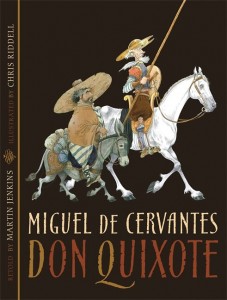 I would not say the same for the second illustrated classics, also from Candlewick Press: Don Quixote. Originally written by Miguel de Cervantes, this hardcover edition is retold by Martin Jenkins and also generously illustrated by Chris Riddell. Every page has at least a line drawing, if not an accompanying full color picture. Many of the line drawings extend full bleed across both pages, while only a few of the color images are allowed to do so. There are, however, dozens of framed, full-page color pictures throughout. To say that this edition is “lavishly illustrated” is an understatement, and yet, it is entirely suitable to the text.
I would not say the same for the second illustrated classics, also from Candlewick Press: Don Quixote. Originally written by Miguel de Cervantes, this hardcover edition is retold by Martin Jenkins and also generously illustrated by Chris Riddell. Every page has at least a line drawing, if not an accompanying full color picture. Many of the line drawings extend full bleed across both pages, while only a few of the color images are allowed to do so. There are, however, dozens of framed, full-page color pictures throughout. To say that this edition is “lavishly illustrated” is an understatement, and yet, it is entirely suitable to the text.
The text itself is a retelling – and one that works well for this particular novel. There would be no doubt in my mind that young adult readers who encounter this version in their youth wouldn’t later seek out the complete version in their more adult years. The two are so very different in style, a curious or devoted reader would be more apt to want to know both. While the language and syntax may be more contemporary and simplified in this retelling, there is certainly no “cleaning up” of the content of the story, which is a relief. Don Quixote’s precarious mental state is as boldly portrayed in this version, as are his repeated beatings and public humiliations – all of which allow the reader to both find humor and deep sympathy for the character. The pace of the text is quick, and the serendipitous adventures kept neatly woven, including Don Quixote’s encounter with Cervantes, the author. For those who have never read this tale or may have forgotten it since high school/early college – it is a densely developed story of many intertwined threads. It is not in any way “light” reading for young adults, but could be categorized as a “smart read” that will entice as well as challenge imaginative young minds.
With the more accessible retelling and addition of magnificent illustrations, this is the kind of book in which young readers will utterly lose themselves – as will any adult, making it a perfect read aloud selection. I highly recommend it for readers who enjoy collecting editions as well as for gift giving; the hardcover, while more pricey, works well with this larger format with heavier paper stock. This is an edition that can remain in a family for generations, and will bring new readers to laugh out loud and shed a tear in their initiation as Don Quixote romantics.
Frank McCourt
Frank McCourt, author of the bestseller Angela’s Ashes, has been fighting skin cancer, but despite all efforts, friends say he has “deteriorated dramatically.”
Snowbound Winners Announced
Tupelo Press has announced Judge Aimee Nezhukumatathil’s selections for the Snowbound 2008-2009 Chapbook Contest:
If St. Augustine Were a Butcher Like My Grandfather by Brandon Som.
The Rafters of David by Kimberly Burwick was runner-up.
Finalists: J. David Cummings, Jennifer Kwon Dobbs, Barbara Duffy, Eileen G’Sell, Susan Gubernaut, Steven Lautermilch, Mary Leader, Mary Molinary, John Surowiecki, Jonathan Weinert.
July is Open Submissions month at Tupelo.
New Lit on the Block :: Lalitamba
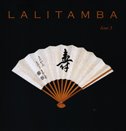 Lalitamba is a journal of modern devotional literature. It includes writings from around the world that have been inspired by different ideas of Truth—Hinduism, Sufism, Judaism, Christianity, and Buddhism, to name a few.
Lalitamba is a journal of modern devotional literature. It includes writings from around the world that have been inspired by different ideas of Truth—Hinduism, Sufism, Judaism, Christianity, and Buddhism, to name a few.
Contributors have been included in the Best American series, written award-winning novels, and received NEA grants. We have also been known to discover new authors, and to publish the writings of people who are homeless or in prison. The writings included are fresh. They challenge the reader to expand, as well as to open to the beauty within. The journal includes fiction, poetry, essays, interviews, translation, and artwork.
The journal was inspired by time spent in India with Sri Mata Amritanandamayi Devi. The name Lalitamba comes from a devotional song. It means Divine Mother, or the power that sustains the universe. The journal is about knowing the truth of inner freedom and joy throughout all circumstance.
Busy Beaver Buttons
Need promo buttons? I got a great product at a very reasonable price from Busy Beaver Buttons, a small, indie company in Chicago. Busy Beaver makes custom buttons, badges, and pins, with some quantities as low as 50, and you can get free shipping. Busy Beaver also started the Button-O-Matic vending machines in 2002 to dispense limited-edition, artist designed buttons across the country. While this might sound like a paid ad – it’s not. I paid them for the work, but considering all the reasearch I had done, shopping around, etc. – I thought for anyone looking for a recommendation, here it is. I found their ad in Make Magazine – another good reason to support them!
BrainStorm Poetry 2009 Contest Winners
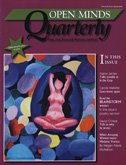 This Spring 2009 issue of Open Minds Quarterly includes the winners of the 7th Annual BrainStorm Poetry Contest for mental health consumers and survivors. Forty finalists were selected from 594 entrants, with the following results:
This Spring 2009 issue of Open Minds Quarterly includes the winners of the 7th Annual BrainStorm Poetry Contest for mental health consumers and survivors. Forty finalists were selected from 594 entrants, with the following results:
First Place – Jennifer Footman
Second Place – Tracy King
Third Place – Ky Perraum
Honorable mentions went to Tracy King, David O’Neal, Michael Conner, Diane Klammer, Benjamin Hawkes, and Ky Perraum.
Open Minds Quarterly is a publication of The Writer’s Circle, a project of NISA/Northern Initiative for Social Action (Ontario). “NISA is built on the premise that consumer/survivors of mental health services are intelligent, creative, and can makea valuable contribution to society if given the opportunity to do so.”
Audio :: Gore Vidal
 A new audio recording of Gore Vidal in conversation with Jay Parini is now available in the online archives of the Key West Literary Seminar. On it, Vidal discuss his work as a historical novelist, his thoughts on the American educational system, and comments on a host of heroes and villains – from Franklin Delano Roosevelt and Tennessee Williams, to George W. Bush, Sarah Palin, and Bernard Madoff.
A new audio recording of Gore Vidal in conversation with Jay Parini is now available in the online archives of the Key West Literary Seminar. On it, Vidal discuss his work as a historical novelist, his thoughts on the American educational system, and comments on a host of heroes and villains – from Franklin Delano Roosevelt and Tennessee Williams, to George W. Bush, Sarah Palin, and Bernard Madoff.
Emerging Writer Fellowships (DC)
The Writer’s Center of metropolitan DC is currently accepting submissions for several competitive Emerging Writer Fellowships. Emerging Writer Fellows will be selected from applicants who have published up to two book-length works of prose and up to three book-length works of poetry. Aug. 15
Cha Give Online Works Second Life
From Cha: An Asian Literary Journal: “We at CHA realise that, sadly, online journals often fold leaving countless works without a home. If you have lost a work in this way, CHA may be interested in republishing your work in our new regular section, ‘Lost Teas’. Please see submission guidelines for more details.”
CHA is the first and currently only Hong Kong-based online literary quarterly journal dedicated to publishing quality poetry, short stories, creative non-fiction, drama, and reviews written in English, as well as photography and art. It has a strong focus on Asian-themed creative work or work done by Asian writers and artists. It also publishes established and emerging writers/artists from around the world.
New Lit on the Block :: Cerise Press
Edited by Fiona Sze-Lorrain, Sally Molini, and Karen Rigby, Cerise Press is a new online international journal based in the US and France.
The inaugural summer issue features poetry by Tess Gallagher, Robert Kelly, Eleanor Wilner, Ray Gonzalez, and Laura Kasischke, among others; translations of Pura L

